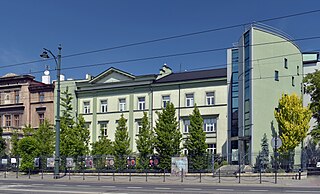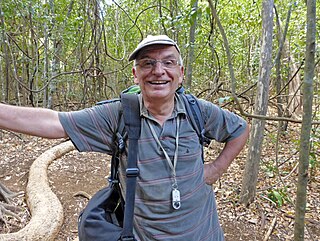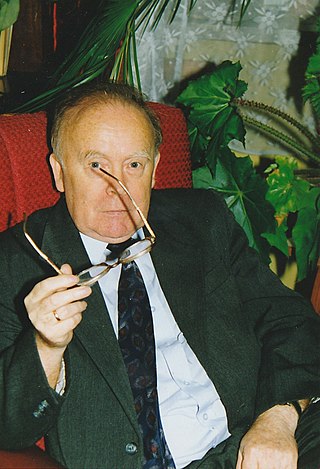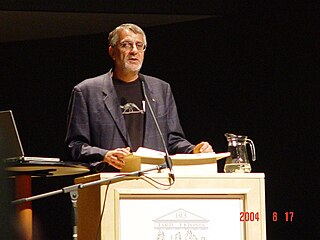Related Research Articles
Wanda Zabłocka was a Polish botanist, phytopathologist and mycologist. She was a professor at Nicolaus Copernicus University in Toruń (1954–1970). Zabłocka was the author of mycology and phytopathology works, including mycorrhiza of Viola. She is also the author of several books about fungi for the general public.

The Władysław Szafer Institute of Botany in Kraków, Poland is a major European herbarium containing a collection of over 650,000 vascular plants, bryophytes, algae, fungi, lichens, and various plant fossils. The vascular plant specimens are primarily from Central Europe with a specialization in alpine plants. The bryophytes are Polish, Antarctic and subAntarctic, and East African. The fossil plants are largely Central European. Main publications include Acta Palaeobotanica, and the Polish Botanical Journal.
André Aptroot is a Dutch mycologist and lichenologist. His primary research focus is on biodiversity, particularly tropical lichens, encompassing systematics, floristic surveys, and taxonomic reviews. A prolific researcher, he has published more than 500 scientific papers and described hundreds of new fungal and lichen species.
Carroll William Dodge was an American mycologist and lichenologist. His major fields of study included human and mammalian parasitic fungi, lichen-associated fungi, and fungi forming subterranean sporophores.

Siti Aisyah Binti Haji Alias is a Malaysian marine polar researcher and lecturer. As of August 2016, she is Associate Professor and Director of the National Antarctic Research Centre (NARC) in the Malaysian Antarctic Research Programme (MARP), at the University of Malaya. Her work focuses on the physiology of marine and polar microbes and fungi.

Elke Mackenzie, born Ivan Mackenzie Lamb, was a British polar explorer and botanist who specialized in the field of lichenology. Beginning her education in Edinburgh, Scotland, Mackenzie later pursued botany at Edinburgh University, earning a Bachelor of Science degree in 1933 and a Doctor of Science in 1942. In the two years she was involved in Operation Tabarin, a covert World War II mission to Antarctica, she identified and documented many lichen species, several of them previously unknown to science.

Lecanora polytropa, the granite-speck rim lichen, is a species of saxicolous (rock-dwelling), crustose lichen in the family Lecanoraceae. A small, inconspicuous species that grows in the cracks of rock surfaces, it has a cosmopolitan distribution and has been recorded on all continents, including Antarctica.
Emanuel David "Rudy" Rudolph was a botanist, lichenologist, and historian of botany. He was "the first botanist to conduct diverse experiments on the total biology of lichens in both polar regions".
Thomas Hawkes Nash III is an American lichenologist. His research is about the biology and ecology of lichens, and the effects of air pollution on plants and lichens. He is known as an authority on the family Parmeliaceae. During his long career at the Arizona State University, he helped develop the lichen herbarium into a world-class collection with over 100,000 specimens representing more than 5000 species. In 2010, the year of his retirement, he was awarded the Acharius Medal for lifetime achievements in lichenology, and the following year had a Festschrift published in his honor.

Emmanuël Sérusiaux is a Belgian lichenologist. His career, spanning more than four decades, has combined both lichenology research and political aspects of nature conservation. He spent several periods working as a researcher at the National Fund for Scientific Research and the University of Liège, the latter in which he accepted a faculty position as professor and head of the Plant Taxonomy and Conservation Biology unit. Sérusiaux also served for three non-consecutive appointments as Deputy Chief of Staff in the Government of Wallonia. He retired from both his academic and political positions in 2019.
Alfred Mycolayovych Oxner was a Ukrainian botanist and lichenologist. His research covered various areas: floristics, taxonomy, phylogenetics, phytogeography, and phytosociology. Oxner founded the National Lichenological Herbarium of Ukraine.

Jan Bystrek was a Polish botanist and professor of natural sciences. He was employed at the Department of Systematic and Geography of Plants at the Maria Curie-Skłodowska University from 1956 until 2004. He published research in many fields, including botany, floristry, lichenology, systematics, environmental protection, biogeography, ecology, bioindication, and nature and landscape protection. He was involved in popularizing knowledge about nature and ecological education.
Sergey Yakovlevich Kondratyuk is a Ukrainian botanist specialising in lichenology. His research deals with the taxonomy, floristics, ecology and geography of lichens and lichenicolous fungi. He has worked at the M.G. Kholodny Institute of Botany of National Academy of Sciences of Ukraine for more than 40 years. In 2014 Kondratyuk was awarded the State Prize of Ukraine in Science and Technology.
James Donald Lawrey is a biologist, specialising in lichens. He is known for leading long-term monitoring projects, taxonomy and studies of the evolution of the fungi in lichens.
Thomas George Allan Green is a lichenologist, terrestrial ecologist and botanist. He is a professor emeritus at the University of Waikato, Hamilton, New Zealand. His work particularly studies how lichens respond to extreme low temperatures and dryness, and especially how this affects photosynthesis. He has studied the ecology of Antarctica.

Pier Luigi Nimis is a senior professor of botany at the University of Trieste in Italy. He specialises in lichenology and phytogeography, including the uses of lichens as indicators of pollution and devising methods for web-based identification keys.
Ludger Kappen is an ecophysiologist, botanist and lichenologist. He was Director of the Botanic Institute and Botanical Garden at the University of Kiel, and Chairman and Director of the University's Polar Ecology Institute.
Josef Poelt was a botanist, bryologist and lichenologist. He held the chair in Systematic Botany and Plant Geography at the Free University of Berlin and then was head of the Botanical Institute and Botanical Garden of Graz University, Austria.
Shackletonia is a genus of lichen-forming fungi in the family Teloschistaceae. The species in the Shackletonia genus are lichenicolous and muscicolous, and known from Antarctica and southern Patagonia.
Walter Watson (1872–1960) was a British lichenologist who made contributions to the study of lichens and bryophytes in the United Kingdom. Born in Greenfield and educated at the University of London, Watson had a long career as an educator, culminating in his role as head of the science department at Taunton School. His research focused primarily on the botany of Somerset, where he settled, and he authored numerous papers on lichen and bryophyte floras. Watson's most notable work, the Census Catalogue of British Lichens (1953), became a foundational resource for mapping lichen distribution in Britain. He received recognition for his contributions to the field, including a Doctor of Science degree from the University of London and honorary associate status with the Linnean Society. Watson's work during periods of reduced interest in lichenology helped maintain continuity in the field, establishing him as a key figure in the history of British lichenology.
References
- 1 2 3 4 5 6 7 8 9 "PORTRETY BOTANIKÓW POLSKICH PORTRAITS OF POLISH BOTANISTS". Archived from the original on 2016-08-22.
- 1 2 3 "Polskie twarde babki - Podróże". podroze.onet.pl (in Polish). 5 March 2008. Retrieved 2016-07-16.
- ↑ "Polish Polar Research" (PDF). www.degruyter.com/. Institute of Botany of the Jagiellonian University. Retrieved 2016-08-14.
- ↑ Riffenburgh, Beau (2007-01-01). Encyclopedia of the Antarctic. Taylor & Francis. ISBN 9780415970242.
- 1 2 "Name details". Australian Antarctic Data Centre. Retrieved 2016-08-14.
- ↑ "Klub Przyjaciół Ziemi Sądeckiej". www.sadeczanie.pl. Archived from the original on 2017-04-17. Retrieved 2016-07-16.